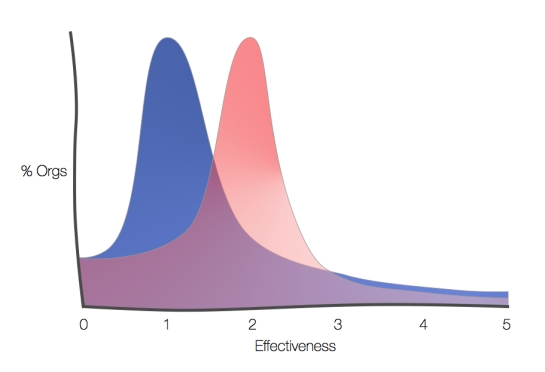What An Effective Group Workshop Looks Like
I have this theory, based on long experience, that folks in most every organisation have little or no understanding of what “effective” looks like. From concept-to-cash product development, to simple workshops and meetings, and even one-to-one conversations, people lack a “standard” against which to compare their own efforts and experiences.
Absent such a standard, many folks seem to assume that they’re doing just fine. And absent an awareness of the scope for doing better, they seek little in the way of techniques or knowledge about how to be more effective. Nor do they often realise – beyond a certain low-key, nagging discomfort – just how much time, energy and opportunity they’re wasting through ineffective behaviours. Of course that’s not the whole story, what with systems that lead inexorably to disengaged people, and collective thinking patterns – a.k.a. mindsets – that underwrite systemic ineffectiveness.
My work with Rightshifting started from the premise that if folks acquired some simple understanding of their organisation’s relative ineffectiveness, they might choose to look, just a little, into the matter of effectiveness. I see few other practical ways to humanely advance the effectiveness of knowlede-work organisations everywhere. And to reduce the egregious waste of human potential we see in most every workplace today.
A Story
This post is a story about what an effective workshop might look like, from the perspective of those folks participating in it. How much is it like the workshops you’ve participated in over the years?
The Newbie
Sandra was feeling apprehensive. The email had been brief. “From: Ellie Lomas at BaCo.com To: Sandra Hardy at BaCo.com Subject: Upcoming Product development workshop. Hi Sandra, We’d love for you to join in the upcoming Product Development Workshop on 17 October. This one-day event will be held in the Marcus Suite of the Brocade Hotel, near our offices. RSVP to reserve a place. You can always cancel later if the details make it appear unsuitable. Thanks, Ellie, Coordinator, BaCo.com”
She’d not been with BaCo long, and didn’t know quite what to expect. The date was still a month away, though, so she made a mental note to talk with some of her colleagues about things.
Over coffee later, she broached the subject with Dave and Rasheeda. “So, I’ve been invited to next month’s Product Development workshop. Have you been on these kinds of thing before?”
Rasheeda smiled. “Yes. I was in a Skilled Dialogue workshop last month. And I’ll be attending this Product Development thing next month, too.” Dave nodded his head as if to say “And me.”
“Did you have the orientation around workshops as part of your induction?” “Oh, um…yes.” said Sandra, recalling that part of her induction week, but not quite remembering what the workshopping section had covered. “I’ve got the notes. I’ll check and remind myself about what we covered.”
Dave laughed. “Yes. They pack a lot into Induction Week, don’t they? Not much of it sticks, I guess. Still, back when I joined we had to figure most of it out for ourselves as we went along. It’s only been for the past six months or so that newbies have had the advantage of a formal Induction Week.”
Sandra couldn’t help but reflect admiringly on the way BaCo had grown its staff support services as its business had grown. She’d not seen that kind of care and attention to fundamentals in the other companies she’d worked for. It gave her a warm and fuzzy feeling, and strengthened her belief that she had made the right choice in accepting the job.
Back at her desk with a second cup of coffee, she browsed through the material from her Induction Week. Ah. Here it was. Workshopping. And her notes on the topic.
“At BaCo, we thrive on folks collaborating. But we’ve found that few folks know how to collaborate effectively. Exploration of the experience of working together, and opportunities to develop skills through both classroom practice and application in real situations can all help. We have regular courses in Skilled Dialogue, which you’re welcome to attend. And you will note in most meetings, workshops and other group sessions within BaCo a certain style of interactions, born of people wanting to see that everyone gets the very best out of the meeting or session.”
She skip-read a few paragraphs until she found the heading “Workshops”. She began reading more intently.
“When you accept a place in a workshop, you’ll receive a list of references – books, articles, videos, and the like – which might help you start thinking about the workshop topic, and give you some entry points into the subject matter. Most often this will include a few general, standard references to workshop-related topics as well as references directly relevant to the topic of the particular workshop at hand.”
“Presently, for all workshops in BaCo, we invite you to have read ‘More Time To Think’ by Nancy Kline and ‘Crucial Conversations’ by Patterson et al.. And more generally, many folks in BaCo are familiar to some extent with the work on e.g. Skilled Dialogue of folks like Argyris, Bohm and Isaacs, too. (See specific references at the end of this section).”
This was a lot of information in a few paragraphs. No wonder it hadn’t really stuck during Induction Week. Sandra wondered if there were any courses on Skilled Dialogue scheduled soon. It seemed like an idea to attend one, if possible, before the Product Development workshop.
She began typing: “From: Sandra Hardy at BaCo.com To: Ellie Loma at BaCo.com Subject: Any Skilled Dialogue courses soon? Hi Ellie, I was just wondering if there were any Skilled Dialogue courses scheduled before the upcoming Product Development Workshop you’ve invited me to? Thanks, Sandra Hardy, Product Owner, BaCo.com” and hit “send”.
A few minutes later, a new email mail popped up her Inbox: “From: Ellie Lomas at BaCo.com To: Sandra Hardy at BaCo.com Subject: Re: Any Skilled Dialogue courses soon?” She was about to go for lunch, but opened the email to read. “Hi Sandra, unfortunately our next Skilled Dialogue course is not until. 24 October. I was already in the process of inviting you to that as a new starter. You’ll be receiving your invitation next week. Here’s a list of upcoming course, including those for Skilled Dialogue. [Elided] Please note you can also find the live list on our intranet at <link>. Please also note that the syllabus for each course is included in the course details, to help you decide how relevant it might be to your needs. Thanks, Ellie, Coordinator, BaCo.com
Lunch
Walking down to the company restaurant, Sandra considered her quandary. Would it be better to decline the Product Development workshop invitation until she’d had the chance to learn something about Skilled Dialogue? Or accept and just go along anyway? She didn’t want to look stupid in front of her new colleagues, nor waste their time stumbling to participate without the necessary skills.
“You’re looking a bit pensive” said Rasheeda, as they walked together into the restaurant. “Penny for them?” “I’m just wondering whether to accept the invite to the workshop next month, given how little I know about BaCo workshops in general, and Skilled Dialogue in particular. Oh. You said you’ve been on a Skilled Dialogue course recently. What do you think?”
Rasheeda thought for a moment then smiled reassuringly. “Remember one of BaCo’s mottos: ‘There’s value in implementation and taking action’. There are many things one doesn’t understand – why not just go ahead and take action; try to do something?”
“Ah, I kinda remember that from Induction Week”, said Sandra, still wondering if she could risk imposing on her coworkers’ time. “I guess you’re worrying about wasting people’s time? Don’t be. People understand that newbies need to find their feet. Everyone’s going to make allowances, and help you out” said Rasheeda.
“And don’t forget, there’s a lot of self-study material, and pointers to resources about Skilled Dialogue, and many other topics, on the BaCo intranet.”
“I hadn’t thought of that. Guess I’ve not got into the BaCo ‘taking the initiative’ way just yet. It’s hard to throw off old habits”, said Sandra. She sighed, but felt excited too, about the prospect of taking an active part in learning something for herself about Skilled Dialogue.
The Learning Starts
After lunch, Sandra dug into the intranet and searched the web, looking for materials and resources on Skilled Dialogue. The intranet had some pointers to some intranet forums where BaCo folks discussed related ideas and topics, shared articles, and generally explored the subject together. She recognised some of the names of forum posters as nearby co-workers.
She also spent some time on Twitter, asking her communities about Skilled Dialogue – and received some helpful-looking references. One in particular caught her attention: “Teaching Smart People How to Learn” by someone called Chris Argyris. She downloaded the PDF to her tablet, making a mental note to read it on the train home.
At the end of the day, she was feeling tired but energised, having made a start in understanding the whole subject of Skilled Dialogue. She was already beginning to see how it could make meetings and workshops go smoother. She had one last thing to do before putting on her coat.
She found Ellie’s email from earlier in the day, and hit “reply”. “From: Sandra Hardy at BaCo.com To: Ellie Lomas at BaCo.com Subject: Re: Upcoming Product development workshop. Hi Ellie, thanks for the invite – and your help with Skilled Dialogue course schedules. I’m delighted to accept the invite to the upcoming Product Development Workshop on 17 October. Thanks, Sandra Hardy, Product Owner, BaCo.com”
The next morning, over breakfast, Sandra found a new email from Ellie waiting for her: “From: Ellie Lomas at BaCo.com To: Sandra Hardy at BaCo.com Subject: Upcoming Product development workshop – Acceptance and Informations. Hi Sandra, Happy to hear you’ll be joining the Product Development Workshop on 17 October. Here’s the advance information going out to all attendees:
For: Sandra Hardy
Specific to this workshop: The topic for the one-day workshop is “Product Development”. In this workshop, we’ll be covering the future direction of Product Development at BaCo – that’s to say, how we believe we can most effectively take new ideas – for whole new products, for little incremental additions to out existing products, and everything in between – and turn them into things which our customers will love – and love to pay for. We know we’ve a ways to go, and that there’s much scope for making this kind of work work better. Here’s a list of references to some relevant books, articles, etc. you might like to take a look at in advance, in preparation for the day:
- Developing Products In Half the Time ~ Smith & Reinertsen
- Managing the Design Factory ~ Don Reinertsen
- The Principles of Product Development Flow ~ Don Reinertsen
- Four Days with Dr Deming ~ Latzko & Saunders
- Agile Product Ownership In A Nutshell ~ Henrik Kniberg (Video)
Note: All books are available via our BaCo company credit account at Amazon.co.uk
Relevant authors include: Bill Deming, Russell Ackoff, Peter Drucker, Peter Senge, Donella Meadows, Allen C Ward, Michael Kennedy, Tom Gilb, John Shook, Jeffrey Liker, Don Reinertsen, John Gall, Douglas McGregor, Taiichi Ohno, Eliyahu Goldratt, John Seddon, Eric Ries, Steve Blank.
Relevant disciplines include: Systems Thinking, Lean Product Development, TPDS, Lean Startup, Theory of Constraints, Product Development, basic Queuing Theory, Hoshin Kanri, Scenario Planning, Value Streams, Value Stream Mapping, the Kano Model.
Relevant links include: <links>
Also please note that you can share in advance, with other attendees, topics and ideas you feel might be useful to explore together on the day. We suggest Twitter as the medium for this, the hashtag is #bacopd17.
General: Attendees at previous workshops have found that a working knowledge of and practice in Skilled Dialogue makes BaCo workshops more effective, a better use of everyone’s time, and results in more insights, actions, mutual exploration and learning.
Here’s a list of references to some relevant books, articles, etc. you might like to take a look at in advance, in preparation for the day:
- More Time To Think ~ Nancy Kline
- Dialogue and the Art of Thinking Together ~ William Isaacs
- Coaching For Performance ~ Sir John Whitmore
- The Five Dysfunctions of a Team ~ Patrick Lencioni
Relevant authors include: Chris Argyris, Bill Noonan, Patterson et al., William Isaacs, Nancy Kline, Patrick Lencioni, Sir John Whitmore, Nonaka & Konno, David Bohm, Peter Senge.
Relevant disciplines include: Skilled dialogue, thinking together, team-building, team coaching, ba.
Relevant links include: <links>
You are registered for this event. Also registered are: Steve Wilson (Facilitating), Dannie Jones, Uppad Misra, Claire Leeson, Rigali Mussolo, Dave Walbrook, Nick Carty and Ken Prather. You can find the live list of registered attendees here: <link>
Thanks, Ellie, Coordinator, BaCo.com”
“Jeez!” Sandra gasped to herself. She suddenly felt overwhelmed. So many books. So many authors. So many disciplines. Almost all of them she’d not even heard of before. “And I’m an experienced Product Owner?”.
Comes The Day
By the day of the workshop, Sandra was feeling all read out. She’d studied Lecioni’s teambullding model and his ideas on better meetings, Noonan’s book on discussing the undiscussable, and Nancy Kline’s work on Thinking Environments. Coaching For Performance has opened her eyes to the potential in people. William Isaac’s stories had inspired her with the power of productive dialogue. But she felt like a total novice, even so. So many more references to follow up. So much knowledge yet to explore. She didn’t know how she was going to cover it all in a lifetime, let alone in the months or years she might be working for BaCo.
And there was the whole other domain of Product Development to cover. She’d believed she knew lots about that. And now, she wondered if she knew anything about that, either. But she knew one thing. She knew she’d found something she loved. At school, study had seemed dry and pointless. But now, to her utter amazement, she had discovered she did have a love of learning. Was this some kind of BaCo conspiracy? Did they know this was one effect of their encouragement to learn? Was it a deliberate and cunning ploy to exploit the workforce? It sure didn’t feel like exploitation.
She bumped into Dannie on the walk to the hotel. “Morning.” “Morning, Dannie.” “Looking forward to it?” Sandra thought about that. “Excited. And daunted.”
They’d reached the revolving door at the entrance to the hotel’s lobby. The conversation paused as they separated to go through the spinning glass and steel. “Ah, I can remember that feeling” said Dannie, taking a deep breath and smiling. “Quite a challenge.”
They followed the BaCo signs to the conference room. Half a dozen other BaCo folks were there already, hanging their coats and stashing their bags. One of the guidelines for BaCo workshops was to avoid using laptops. Several folks already had their tablets or smartphones out and were connecting to the hotel Wifi. The large screen showed the BaCo logo, the title of the day’s workshop, and a clock ticking in the lower corner.
“Welcome”, said “Bruce” – Sandra guessed, a hotel employee, by his badge and his dress. “Tea or coffee?” “Thanks” said Sandra, moving to take a cup, tea bag, and hot water from the urn on one of the side table.
While she was adding the milk to her tea, Ellie walked in, carrying a box under her arm. “Stationery and stuff!” she exclaimed, putting the box down on a side table towards the front of the room. “Get it while it’s hot! Everybody help themselves, as you need to.”
Sandra guessed most of the attendees had arrived by now. Most were chatting in groups of twos and threes, some animatedly, some more relaxed. She walked over to where Dannie was chatting with a dark-skinned woman. “Sandra, you know Uppad? She’s working on the Logix product at the moment.” They exchanged greetings. Sandra was unsure as to how to continue the conversation, but Uppad helped her out. “So you’ve been here a month now? Getting into the swing of things?” Sandra thought about saying no, about sharing her awe at the amount of stuff she now knew she didn’t know, but was cut short by Steve, the facilitator, tapping the bell for the room’s attention. “It’s two minutes to Nine, so who’s for getting started?” Everybody took their seat and most opened their Twitter apps. Some tweeted what Sandra guessed as a few words about the start of the workshop.
“Ok, how do we want to start?” asked Steve. “Do we want an amanuensis stroke cybrarian?” asked Nick. “If so, who’d like to do that?” Sandra had read about this role, and spoke up. “I’d like to do it. Except I don’t know much about it. Would it be OK to have a newbie?”
“Ah” said Nick. “All you have to do” he said, tilting his head down and looking up at her with a wry smile “is to tweet things that might be interesting for the group here, and maybe for other folks across BaCo, too. Our hashtag today is up there next to the Wifi code. He pointed to an A2 Post-it stuck to the wall with “#bacopd17” written on it. Tweet things like references to any key ideas that get mentioned, or any insights that emerge. Saves us all each writing our own notes. Also, we’ve found it’s handy to have topical images, book covers, quotes, notes, etc. visible on the big screen. Oh, and you might find using that laptop – with its keyboard and screen – more convenient than your tablet. Being our amanuensarian might help you pick things up quicker than just sitting quietly and listening?”
“Anyone else burning to do it?” asked Steve.
No one seemed keen to deny Sandra the opportunity, so she moved over to the vacant seat at the laptop controlling the big screen. Once seated, she called up a browser in one window and projected it onto the screen for all to share, whilst opening twitter in another, shared window, showing the live #bacopd17 hashtag stream.
“Ok.” said Steve. Do we want an agenda? “How about just throwing some topics onto some post-its, and choosing as we go?”
“Everyone nodded.” The Lean Coffee – like format was well-know and well-liked amongst those present.
“First – standard – topic is ‘Why are we here?’”. How about we make a start on that whilst we have some time to note what we’d each personally like to cover today?
Steve wrote something on a Post-It and stood to place the note on the flip chart. “Why are we here?” Sandra knew enough about this format of meeting to start the timer counting down the eight minutes they’d spend on the topic. The countdown appeared, discreetly, in one corner on the big screen.
Each person in turn shared their reasons for attending the workshop, speaking about how they were feeling being there, what they thought they needed to get out of the day, and any requests they had in that regard. Each also spoke to their shared common purpose for the workshop. Sandra noted how everyone appeared to have spent some considerable time thinking about these things in advance. She herself had been using the #bacopd17 hashtag stream as a window into such thinking for a week or two previously.
As each person talked, the others listened intently, looking down occasionally to make a note or two. And Sandra, as amanuensarian, trawled through the hashtag stream for more candidate topics – those that had been tweeted over the past few weeks.
Although Sandra has been at some dozen BaCo meeting since her first day, she was still very struck by the no-nonsense, matter-of-fact way in which everyone in BaCo meetings just got right down to it. Idle chat, off-topic conversations and pleasantries were conspicuous by their absence. Everyone listening carefully, processing what they heard, and only so very occasionally speaking in response to something said. She could clearly see the influence of Nancy Kline’s work in action.
Choosing a Topic
[Choosing a topic – tbd]
Every time someone mentioned an idea or reference that she felt deserved special attention and sharing, Sandra would google for it and display some likely helpful information or image on the big screen. All the while, the twitter stream was updating in near real time with tweets from within and without the room.
[Illustrate engagement and constructive conflict – tbd]
And the Day is Done
“It’s a wrap!” Steve exclaimed. Everyone smiled. And sighed. It had been a long day. And the workshop wasn’t over yet. Everyone stood, gathered their possessions, bags and coats. As they filed out of the room, a few lingered to discuss this or that.
On her train home, Sandra reflected on her first BaCo workshop. It had been a good choice, volunteering as the amanuensarian. She’d learned a lot, through having to look up references, thinking about what to display on the big screen, and keeping abreast of both the twitter stream and the conversation in the room. The amanuensarian role had helped in making more of it stick.
She took her smartphone and scrolled back through the day’s twitter stream. Plenty there to catch up on and delve deeper into over the next few days. And folks not present in the meeting had contributed some interesting stuff too. Even some folks outside of BaCo. She ‘followed’ everyone who had contributed something.
She replied to or retweeted a few of the day’s tweets, before relaxing into her seat and listening to some tunes, as the train rocked along, homeward.
End.
A Model
The above story illustrates a range of features of an effective workshop:
- Certain shared proficiencies in e.g. Skilled Dialogue, Lean Coffee, etc..
- Pre-reading (shared), including “standard” texts – here including Nancy Kline and Chris Argyris.
- Clarity of purpose “just why are we here?”.
- Shared purpose “we’re all here for the same things”.
- Folks tweeting and googling continuously during the workshop.
- Amanuensis / cybrarian to facilitate shared learning in the workshops.
- Democratic agenda-setting.
- Mutual exploration of topics.
- Active curiosity.
- “Essentiality” – avoidance of rabbit-holes and extraneous discussion of details.
- Focus on impacts (as compared to busyness, or outputs, or even outcomes).
- Post-reading – following up new references.
- Follow-up conversations, actions.
- Feedback.
– Bob
Afterword
In writing this story, it seemed to me that a video of a workshop in action would be a great addition to the resources available to BaCo staff to help them appreciate the nature of an effective workshop. Maybe one day I’ll have the opportunity to write and/or direct such a video.
Further Reading
What is Dialogue? ~ Susan Taylor (pdf)





